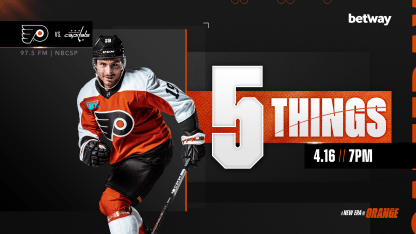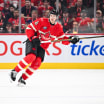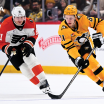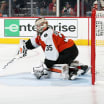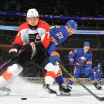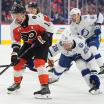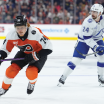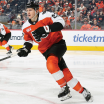Playing the 82nd and final game of the 2023-24 regular season, John Tortorella's Philadelphia Flyers (38-31-11) will host Spencer Carbery's Washington Capitals (39-31-11 on Tuesday evening. Game time at Wells Fargo Center is 7:00 p.m. EDT.
The game will be televised on NBCSP. The radio broadcast is on 97.5 The Fanatic with an online simulcast on Flyers Radio 24/7.
This is the third and final meeting of the season series between the teams, and the second game in Philadelphia. The Flyers are 1-1-0 to date against the Capitals.
Playing for the third time in four nights, the Capitals are coming off a 2-0 home shutout win over the Boston Bruins on Monday evening. The Flyers have had two nights off since eeking out a 1-0 home win over the New Jersey Devils on Saturday behind a Travis Konecny shorthanded goal (33rd) and a 20-save shutout by Samuel Ersson.
In order for the Flyers to earn a spot in the Stanley Cup playoffs, Philadelphia needs all of the above to happen: 1) A regulation win over the Capitals, 2) a Montreal Canadiens home regulation win over the Detroit Red Wings, and 3) a New York Islanders home regulation win over the Pittsburgh Penguins on Wednesday. That combination -- and that combination only -- would have the Flyers beat out the Red Wings (regulation wins, 31-27) and Capitals (head-to-head record, since each of the first three tiebreakers would be a dead heat), while finishing one point ahead (89 to 88) of the Penguins.
Here are five things to watch on Tuesday:
1. Follow the process of the last two games
The Flyers cranked out a pair of strong all-around performances against the New York Rangers last Thursday and the Devils on Saturday. The one thing the Flyers received in the New York game but not against New Jersey was goal support for Ersson.
The chances were there -- Tyson Foerster alone had three, Sean Couturier and Owen Tippett had two apiece, Morgan Frost had another (with a rebound chance for Tippett created on the doorstep) -- despite generating a modest 21 shots on goal overall. Thankfully for the Flyers, Ersson and the team defense were able to make the skinny 1-0 lead hold the rest of the way.
- The Flyers best player this season, Konecny, delivered standout performances with three points (2g, 1a) in the last two games. On Thursday, the Flyers got vital supporting offensive contributions with goals by Cam York, Bobby Brink and Noah Cates, as well as two assists by Ryan Poehling. On Thursday, the Flyers need several players who've been unable to produce points lately -- Tippett, Frost, Tyson Foerster, Couturier, etc. --- to deliver a key goal or assist with the season on the line.
- Turning defense into offense: All four goals by the Flyers against the Rangers were scored on transition plays. Konecny's shorthander against the Devils was also a transitional rush.
- Going to the net. All four Flyers goals in the Rangers game featured a player going to the net, whether or not he recorded a point on the play. They needed more of those sorts of plays against the Devils, but the aforementioned point-blank chance for Tippett in the second period was one such play.
- Tenacious forechecking and diligent backchecking, up and down the lineup. The Flyers fought for every puck and battled for every foot of real estate, across all three zones. It didn't matter whether the Flyers had the puck, were fighting to win a 50-50 puck, or were tracking back defensively. The Flyers did this in each of the last two games.
- Sacrificing for success: The Flyers blocked 19 shot attempts by New York in Thursday's game. Garnet Hathaway led Philly with five blocks, while York had three. Against the Devils ,the Flyers blocked 22 shots led by four Ryan Poehling blocks and three by Travis Sanheim.
- Airtight closeout: The Flyers limited the perpetually dangerous Rangers to a mere two shots on goal in the third period. The Rangers never got even a sniff of a potential comeback. The Devils had only 14 shots on goal over the final 40 minutes of the game.
- Last but certainly not least, Samuel Ersson delivered a standout performance in goal. On 25 shots on goal in New York, he limited the Rangers to a single five-on-three power play tally. He was flawless against New Jersey.
If the Flyers can execute the same type of process -- offensively, defensively, and in goal -- they will maximize their chances of defeating the Capitals in the season finale.
Side note: Because a regulation tie would do the Flyers no good in the standings, look for the Flyers to pull Ersson for an extra attacker if the score is tied late in regulation. Philly hopes, of course, that this does not become necessary.
2. Flyers likely to go with the same personnel as the last two games.
The Flyers held their final practice of the regular season on Monday at the FTC in Voorhees. Unsurprisingly, given how well the club played in the last two games and the do-or-die nature of Tuesday's game, the practice featured all of the same personnel and line combinations from the last two games.
The three forwards -- Nicolas Deslauriers, Olle Lycksell and Denis Gurianov -- who were healthy scratches against the Rangers and Devils were all clad in gray practice jerseys. They skated together. So, too, did black-clad Marc Staal, Ronnie Attard and Adam Ginning -- when there were blueline reps.
Tortorella never publicly confirms a starting goaltender prior to gameday. However, it would be to much surprise if Ersson (23-18-7, 2.86 goals against average, .890 save percentage, four shutouts) is not between the pipes. If a relief goaltender is needed, such as in the event of injury, Ivan Fedotov (0-1-1. .811 save percentage) has made one start and two relief appearances since joining the Flyers.
3. Puck possession and 5-on-5 goal differential
From a 5-on-5 puck possession and shot suppression standpoint, the Flyers have taken a big jump this season. Entering the season finale, the Flyers rank eighth in shot attempt share (51.51 percent Corsi) at 5-on-5, second in fewest opposing shots on goal per game (27.2), tied for fourth in shots on goal generated per game (33.1) and second in blocked shots per 60 minutes of play (18.39).
Nevertheless, the Flyers come into the finale having allowed 26 more goals (256) than they've scored (230). Specific to 5-on-5 play, the Flyers have scored 158 goals while allowing 179.
Meanwhile, the Capitals have one of the most unfavorable season goal differentials -- 214 goals for vs. 251 goals against -- of any prospective playoff team in recent NHL history. The Caps rank 26th in team Corsi at 5-on-5, 30th in shots generated per game (26.6), tied for 21st in shot suppression (30.6 opposing shots on goal on average) and sixth in shot-blocking (16.87 per 60).
Underling numbers become meaningless if a team doesn't win when it matters most, however. Likewise, they're a footnote to a win. Also keep in mind: The Capitals shut out the Bruins and held Boston to 18 shots on goal in Monday's game.
4. Flyers special teams vs. Caps special teams
It's now or never for the Flyers to avoid the fate of posting the worst power play percentage in franchise history since the NHL officially started tracking power play data in 1977-78. Mired in a current 0-for-23 drought, the Flyers have dropped to 12.3 percent on the power play this season.
Officially, the 2021-22 season (12.6 percent) was the low-water mark in team history. Based on boxscore research, the inaugural 1967-68 season (12.3 percent) was unofficially the worst power play season since the Flyers entered the NHL.
On the final day of the 2021-22 season, the Flyers actually scored two power play goals (ex-Flyer James van Riemsdyk and Tippett). With much more riding on the game this time around, generating a PPG or two against the Caps might be the difference between checking the scoreboard afterward for the Detroit vs. Montreal score and the other games being academic for Philly.
The Capitals rank 18th in the NHL on the penalty kill this season (78.9 percent). They've scored three shorthanded goals.
The Flyers penalty kill, ranked at or near the top of the NHL for the first five months of the season. They've hit a rut down the stretch, dropping to fourth in the NHL (83.4 percent). Recently, however, the Flyers have done a good job of staying out of the penalty box.
With 16 shorthanded goals scored this season, the Flyers lead the NHL by a wide margin (Dallas is second with 12). Konecny has scored six shorthanders, followed by Poehling with three, Scott Laughton with two, ex-Flyer Sean Walker with two, and one apiece for Hathaway, Travis Sanheim and Foerster.
The Capitals power play ranks tied for 17th in the NHL this season at 20.6 percent. Washington has allowed five shorthanded goals.
5. Behind Enemy Lines: Washington Capitals
The Capitals have a big decision to make for Tuesday. Charlie Lindgren (24-17-7, 2.71 GAA, .910 save percentage) shut out the Bruins on Monday and saw just 16 shots overall. Would Washington stay with the recently hot hand and start Lindgren three times in four nights to close out the season?
Alternatively, the Capitals could turn to Darcy Kuemper (13-14-3, 3.31 GAA, .890 save percentage, one shutout). Kuemper made 41 saves in a losing cause against Carolina on April 5, but was pulled (four goals on 22 shots) against Carolina back on March 22 and was touched up for seven goals by Edmonton on March 13.
Washington no longer has some of the cadre of top offensive talent the club featured throughout the 2010s into the 2020s. However, Alex Ovechkin (30g, 64 points) is still mighty dangerous and a potential gamebreaker on any given night. Familiar Caps names such as offensive defenseman John Carlson (52 points) and Tom Wilson (18 goals, 131 PIM, three-game point streak) are still on hand. Dylan Strome leads the club with 67 points (27g, 40a).
Beck Malenstyn had to leave Monday's game against the Bruins with an upper-body injury. He did not return. The player's availability for Tuesday is unknown as of this writing.

